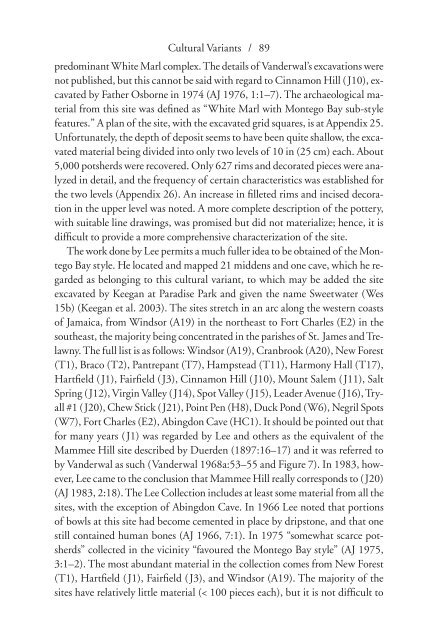Pre-Colombian Jamaica: Caribbean Archeology and Ethnohistory
by Phillip Allsworth-Jones
by Phillip Allsworth-Jones
Create successful ePaper yourself
Turn your PDF publications into a flip-book with our unique Google optimized e-Paper software.
Cultural Variants / 89<br />
predominant White Marl complex. The details of V<strong>and</strong>erwal’s excavations were<br />
not published, but this cannot be said with regard to Cinnamon Hill (J10), excavated<br />
by Father Osborne in 1974 (AJ 1976, 1:1–7). The archaeological material<br />
from this site was defined as “White Marl with Montego Bay sub- style<br />
features.” A plan of the site, with the excavated grid squares, is at Appendix 25.<br />
Unfortunately, the depth of deposit seems to have been quite shallow, the excavated<br />
material being divided into only two levels of 10 in (25 cm) each. About<br />
5,000 potsherds were recovered. Only 627 rims <strong>and</strong> decorated pieces were analyzed<br />
in detail, <strong>and</strong> the frequency of certain characteristics was established for<br />
the two levels (Appendix 26). An increase in filleted rims <strong>and</strong> incised decoration<br />
in the upper level was noted. A more complete description of the pottery,<br />
with suitable line drawings, was promised but did not materialize; hence, it is<br />
difficult to provide a more comprehensive characterization of the site.<br />
The work done by Lee permits a much fuller idea to be obtained of the Montego<br />
Bay style. He located <strong>and</strong> mapped 21 middens <strong>and</strong> one cave, which he regarded<br />
as belonging to this cultural variant, to which may be added the site<br />
excavated by Keegan at Paradise Park <strong>and</strong> given the name Sweetwater (Wes<br />
15b) (Keegan et al. 2003). The sites stretch in an arc along the western coasts<br />
of <strong>Jamaica</strong>, from Windsor (A19) in the northeast to Fort Charles (E2) in the<br />
southeast, the majority being concentrated in the parishes of St. James <strong>and</strong> Trelawny.<br />
The full list is as follows: Windsor (A19), Cranbrook (A20), New Forest<br />
(T1), Braco (T2), Pantrepant (T7), Hampstead (T11), Harmony Hall (T17),<br />
Hartfield (J1), Fairfield (J3), Cinnamon Hill (J10), Mount Salem (J11), Salt<br />
Spring (J12), Virgin Valley (J14), Spot Valley (J15), Leader Avenue (J16), Tryall<br />
#1 (J20), Chew Stick (J21), Point Pen (H8), Duck Pond (W6), Negril Spots<br />
(W7), Fort Charles (E2), Abingdon Cave (HC1). It should be pointed out that<br />
for many years (J1) was regarded by Lee <strong>and</strong> others as the equivalent of the<br />
Mammee Hill site described by Duerden (1897:16–17) <strong>and</strong> it was referred to<br />
by V<strong>and</strong>erwal as such (V<strong>and</strong>erwal 1968a:53–55 <strong>and</strong> Figure 7). In 1983, however,<br />
Lee came to the conclusion that Mammee Hill really corresponds to (J20)<br />
(AJ 1983, 2:18). The Lee Collection includes at least some material from all the<br />
sites, with the exception of Abingdon Cave. In 1966 Lee noted that portions<br />
of bowls at this site had become cemented in place by dripstone, <strong>and</strong> that one<br />
still contained human bones (AJ 1966, 7:1). In 1975 “somewhat scarce potsherds”<br />
collected in the vicinity “favoured the Montego Bay style” (AJ 1975,<br />
3:1–2). The most abundant material in the collection comes from New Forest<br />
(T1), Hartfield (J1), Fairfield (J3), <strong>and</strong> Windsor (A19). The majority of the<br />
sites have relatively little material (< 100 pieces each), but it is not difficult to


















